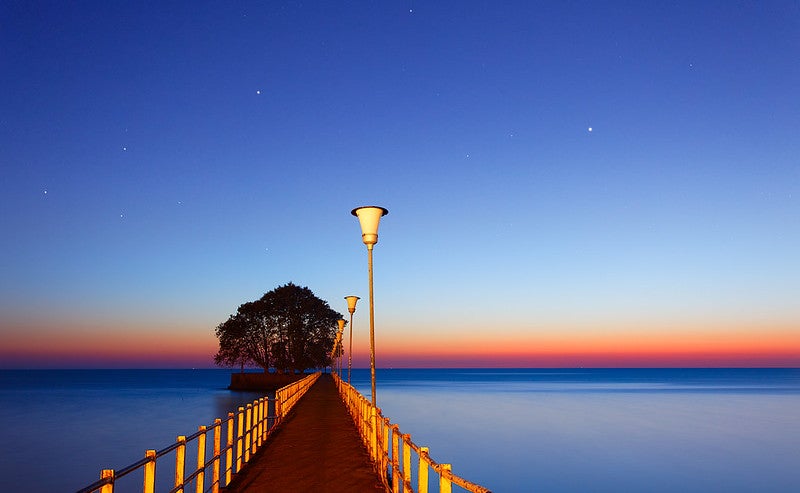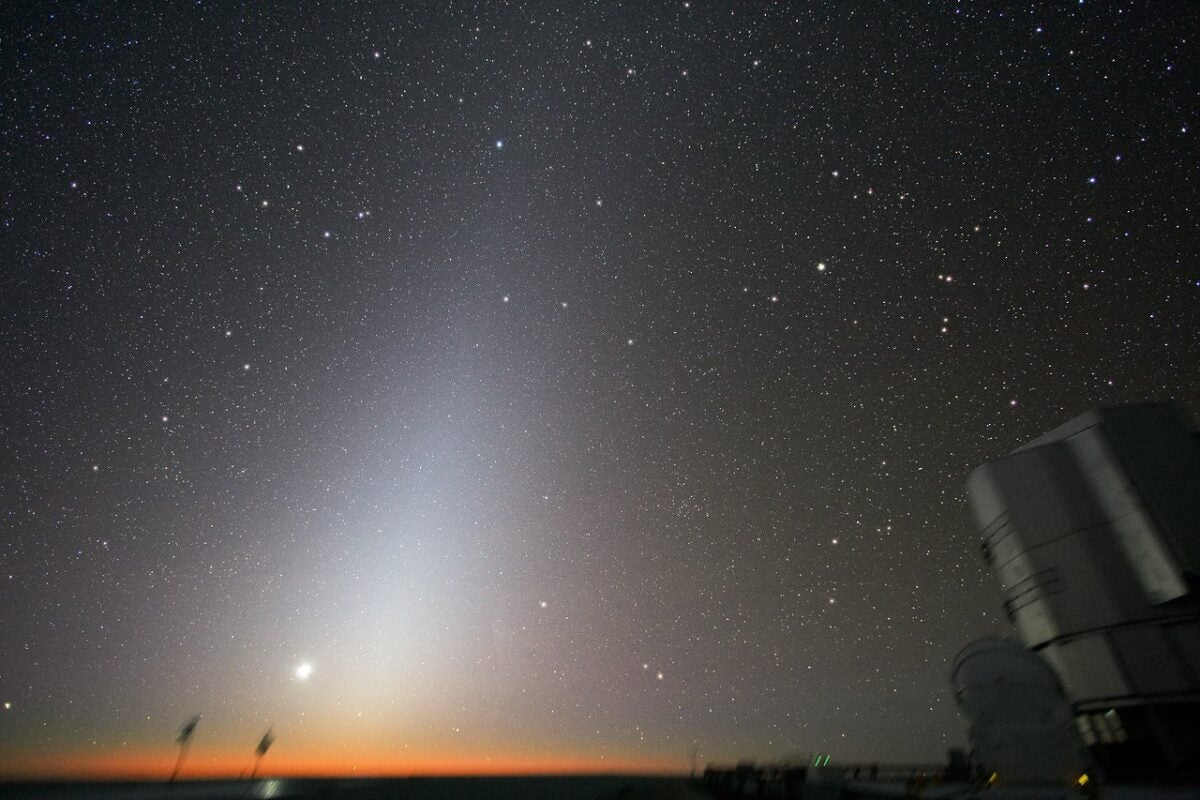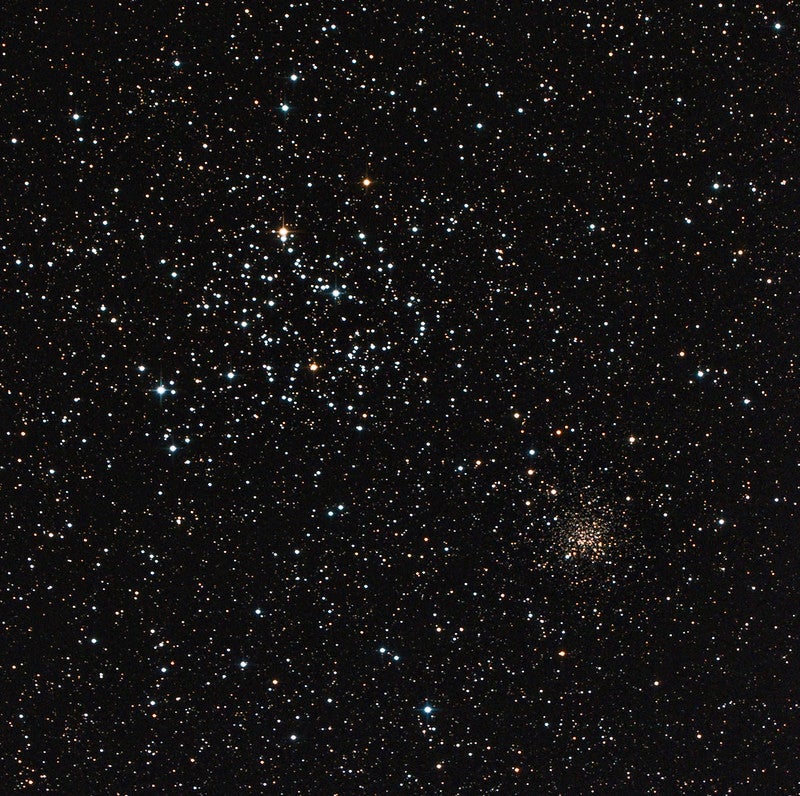
Friday, August 30
The Great Square of Pegasus is rising in the east as darkness starts to fall after sunset. This large asterism is the most recognizable portion of the Winged Horse. It is bounded by four stars, yet only three of these are in the constellation Pegasus — the fourth is in neighboring Andromeda, just over the border between the two star patterns.
By two hours after sunset, the entire Square is visible and its center is some 30° above the eastern horizon. Let’s start with the northwesternmost star, magnitude 2.4 Scheat, cataloged as Beta (β) Pegasi. This is the second-brightest star in the asterism and may appear through binoculars or a telescope to have a yellow or reddish tint, as it is a cooler, aging red giant star.
Moving clockwise to the star at the southwestern corner of the Great Square you’ll find magnitude 2.5 Markab, Pegasus’ alpha star — despite being fainter than both Beta and Epsilon (ϵ) Peg. Although it has just begun to enter the latter stages of its life, this star still glows blue-white, particularly compared to Scheat.
Continuing clockwise, the southeasternmost star in the Great Square is Algenib (Gamma [γ] Peg). This is the faintest star in the asterism (magnitude 2.8) but also glows blue, as it’s a B-class star some 4,000 times more luminous than the Sun.
Finally, we reach Alpheratz at the Great Square’s northeastern corner. The brightest star in the Square (magnitude 2.1), this is a bit of an “interloper,” as it’s also Delta (δ) Andromedae and now belongs officially to the Maiden. Also a class B star, Alpheratz is less intrinsically luminous than Algenib, shining with just some 200 times the luminosity of our Sun.
The Great Square — along with the rest of Pegasus — will continue to rise higher in the sky until the early-morning hours, transiting around 2 A.M. local daylight time.
Sunrise: 6:26 A.M.
Sunset: 7:34 P.M.
Moonrise: 2:40 A.M.
Moonset: 6:15 P.M.
Moon Phase: Waning crescent (11%)
*Times for sunrise, sunset, moonrise, and moonset are given in local time from 40° N 90° W. The Moon’s illumination is given at 12 P.M. local time from the same location.
Saturday, August 31
The solar system’s innermost planets are putting on a show this week; whether you’re an early riser or prefer to start observing after sunset, there’s something for you to see.
Let’s start in the predawn sky, as Mercury is quickly approaching its greatest elongation from the Sun in just a few days. This morning, the planet hangs 13° below the waning crescent Moon, rising some 80 minutes before the Sun. Now magnitude 0.7, Mercury will brighten in the coming days. Still, it should be visible in the hour before sunrise, as it steadily rises in the east beneath the chin of Leo the Lion. Through a telescope, you’ll easily note that the planet is only partially lit, just 26 percent illuminated. Its disk spans 8″.
Above the planet, the Moon is in Cancer, presenting just a slim crescent barely more than 5 percent lit this morning. It stands to the left of the Beehive Cluster (M44), which may be difficult to see as the sky brightens, so try to catch this cluster earlier rather than later. Spanning nearly 100′ — almost as large as the Pleiades — the Beehive, also known as Praesepe the Manger, is visible to the naked eye under good conditions and will pop right out in binoculars or a telescope.
Farther west along the ecliptic, higher in the sky, is Taurus the Bull, which houses Mars near its eastern border, Jupiter between the Bull’s horns, and Uranus southeast of the Pleiades in the western portion of the constellation.
On the flipside, evening observers can try to catch the second-closest planet to the Sun, though you must be quick — Venus is just 5° high 30 minutes after sunset, hanging low in the west in western Virgo. See how long it takes for that constellation’s alpha star, magnitude 1 Spica, to become visible in the falling dusk. (The Moon will pass close to this star on Friday, obscuring it entirely for some observers — stay tuned.)
Unlike Mercury, though, Venus is blazingly bright at magnitude –3.9, making it easy to spot as long as your horizon is clear. If that horizon allows, turn a telescope on Earth’s sister planet. Venus is now 92 percent lit, presenting a nearly full face to us. The planet’s disk stretches 11″ on the sky.
Sunrise: 6:27 A.M.
Sunset: 7:32 P.M.
Moonrise: 3:46 A.M.
Moonset: 6:46 P.M.
Moon Phase: Waning crescent (5%)
Sunday, September 1
Now in Leo, the Moon passes 5° north of Mercury at 5 A.M. EDT — note the pair rises just minutes after 5 A.M. local daylight time, so this configuration may just be visible for some observers on the East Coast. Others will see the Moon pulling progressively farther to the planet’s northeast in the early-morning sky.
Uranus reaches its stationary point at noon EDT today. The ice giant lies in western Taurus, near the famous Pleiades star cluster, and is visible in the early morning. The best time to view it is a few hours before sunrise, when the planet is high but the sky is still quite dark. That’s because Uranus glows dimly at magnitude 5.7, likely requiring binoculars or a telescope to view. (Make sure to turn you binoculars or telescope to the Pleiades as well to enjoy them, though keep the power low — the cluster is so spread out on the sky that you’ll lose many of its stars at high power.)
If your sky is clear, the air is steady, and Uranus is high above the horizon, see if you can just spot it without optical aid, some 5° southwest of the Pleiades.
Sunrise: 6:28 A.M.
Sunset: 7:31 P.M.
Moonrise: 4:51 A.M.
Moonset: 7:11 P.M.
Moon Phase: Waning crescent (2%)

Monday, September 2
With New Moon occurring at 9:56 P.M. EDT, today offers a perfect opportunity to look for the zodiacal light. Now visible in the morning sky before sunrise, it will appear as a soft, cone-shaped glow thrusting up from the eastern horizon along the ecliptic (the plane of the solar system, along which the planets lie). Look for the wide base starting in Leo, then narrowing as it passes up through Cancer and Gemini.
This gentle glow comes from sunlight glinting off dust and debris left by comets as they travel through the inner solar system. Over time, this debris settles onto the plane of the ecliptic, which is why we see the concentrated glow there. The zodiacal light is quickly washed out by light pollution, so you’ll want to get to a location free of artificial lights and with a clear eastern horizon. Getting a little above your surroundings will help as well. To better help you find the ecliptic, look for the planets in the morning sky — Mercury is lowest to the horizon in Leo as it rises, while Mars and Jupiter are high in the southeast in Taurus. Draw an imaginary line connecting these planets —that’s the ecliptic, where you can expect the zodiacal light to appear.
Sunrise: 6:29 A.M.
Sunset: 7:29 P.M.
Moonrise: 5:55 A.M.
Moonset: 7:34 P.M.
Moon Phase: New
Tuesday, September 3
The ringed planet Saturn reaches opposition next week, rendering it visible roughly all night long. You can find it shortly after sunset, rising in the east in the constellation Aquarius and outshining all the stars around it. Now is the best time to observe the planet. Zoom in with a telescope and you’ll see its large disk spans 19″, with the rings stretching roughly 43″. They are tilted just 3.6° to our line of sight, presenting a relatively thin profile.
Saturn is wreathed in moons, the largest and brightest of which is Titan, this evening located just over 2′ west of the planet. On the other side of the world, Iapetus reaches greatest eastern elongation, located a full 9.3′ to the planet’s east. At eastern elongation, Iapetus is also at its faintest, glowing a meager 12th magnitude and dropping out of easy view in small scopes. Brighter, 10th-magnitude Tethys, Rhea, and Dione sit much closer to the planet — in fact, Tethys emerges from an occultation behind the planet to appear just north of the rings on Saturn’s eastern side shortly before 11 P.M. EDT. Rhea and Dione sit just west of the planet: Rhea is closest, with Dione a little farther west, though Rhea is moving west and Dione is moving east. Dione passes due north of Rhea shortly after midnight EDT (still late on the 3rd farther west), and after that will lie closer to the planet.
Sunrise: 6:30 A.M.
Sunset: 7:28 P.M.
Moonrise: 6:55 A.M.
Moonset: 7:53 P.M.
Moon Phase: New
Wednesday, September 4
Mercury reaches greatest western elongation 18° from the Sun at 11 P.M. EDT, now appearing at its best for the year for early-morning Northern Hemisphere observers. As earlier this week, you’ll find it in the predawn sky, already 5° high in the east an hour before sunset and reaching some 15° high by sunrise. The tiny planet now shines at magnitude –0.2 and is 42 percent lit, though it has dropped slightly in apparent size to 7″. In the coming weeks, the planet will appear to sink back toward the horizon at the same time each morning, brightening dramatically as it goes. We’ll follow it until it finally drops out of sight later this month.
The bright star Regulus, the heart of Leo the Lion, is chasing Mercury up into the morning sky. See if you can spot this star, which clears the horizon around 5:30 A.M. local daylight time, standing to Mercury’s lower left. At magnitude 1.4, Regulus is relatively bright and will linger as twilight paints the sky. Compare it — and how long it remains visible to the naked eye — with other stars such as Castor and Pollux (magnitude 1.6 and 1.2, respectively) in Gemini, Betelgeuse and Rigel (magnitude 0.5 and 0.2, respectively) in Orion, andmagnitude –1.4 Sirius in Canis Major, now in the southeast.
Sunrise: 6:31 A.M.
Sunset: 7:26 P.M.
Moonrise: 7:55 A.M.
Moonset: 8:12 P.M.
Moon Phase: Waxing crescent (2%)

Thursday, September 5
Mars is nearing the border of Taurus and Gemini in the early-morning sky, standing just less than 1° from 4th-magnitude 1 Geminorum. Now shining at magnitude 0.7, the Red Planet is slowly brightening as it approaches opposition early next year. By the end of the month, it will gain another 0.2 magnitude.
Also near 1 Gem is the open cluster M35, which glows at 5th magnitude and spans 28′. The cluster is just 1.5° northeast of the star and a little over 2° east-northeast of Mars, so use these two bright points as stepping-stones to find the group of young stars. You should be able to easily pick it up in binoculars or any telescope. It contains several hundred members and, with some magnification, you might also pick up the smaller, more compact magnitude 8.6 cluster NGC 2158, about half a degree to M35’s southwest. Mars will continue moving toward this region, passing closest to M35 next week — we’ll highlight it in the next column.
The Moon passes 1.2° south of Venus at 6 A.M. EDT, though neither is visible at that time.
A few hours later, the Moon reaches apogee, the farthest point from Earth in its orbit, at 10:54 A.M. EDT. At that time, our satellite will sit 252,408 miles (406,211 kilometers) away. The now-waxing crescent will be visible in the daytime, though its thinness may make finding it difficult. The best views will come looking west around sunset, with the Moon now to Venus’ upper left. We’ll check back in tomorrow, as the Moon passes close to the bright star Spica.
Sunrise: 6:32 A.M.
Sunset: 7:24 P.M.
Moonrise: 8:54 A.M.
Moonset: 8:31 P.M.
Moon Phase: Waxing crescent (6%)
Friday, September 6
The Moon passes 0.5° north of Spica at 1 P.M. EDT; some observers will see our satellite cover the star in an occultation visible from west-central Africa, the northeastern U.S., and eastern Canada. If you’re in one of those regions, visit the International Occultation Timing Association’s webpage for the event for the timing — heavily location dependent — in the region nearest you. Make sure to take the appropriate precautions if you plan to observe the occultation in daylight.
The Moon will keep moving through the sky and by sunset lies to Spica’s upper left. Our satellite is now more than 10 percent lit, showing off its eastern limb. The pair is visible for a little over an hour after sunset as Virgo sets in the west, with the Moon now a few degrees from the star. Both should still be visible together in binoculars, though the higher-powered field of view of a telescope may prove too limited.
Immediately after sunset, Venus is visible too, still shining at magnitude –3.9. It lies to the lower right of the Moon and Spica in the sky.
Sunrise: 6:33 A.M.
Sunset: 7:23 P.M.
Moonrise: 9:54 A.M.
Moonset: 8:51 P.M.
Moon Phase: Waxing crescent (11%)

Sky This Week is brought to you in part by Celestron.









